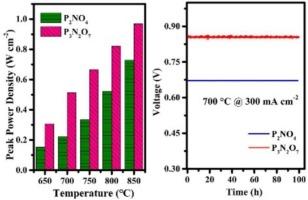Ruddlesden-popper Prn+1NinO3n+1 (n = 1, 2) oxides with in situ exsolved Ni nanoparticles as high-performance anodes for intermediated-temperature solid oxide fuel cells
IF 4.1
3区 化学
Q1 CHEMISTRY, ANALYTICAL
引用次数: 0
Abstract
In recent years, the in-situ exsolution of metal nanoparticles from the anodic oxide framework through reduction treatment has emerged as an effective strategy to boost electrochemical performance by increasing active sites and facilitating charge transfer. However, this approach is primarily restricted to simple perovskite structures. The development of novel and more efficient oxide matrices for the controlled desorption of high-density metal catalysts remains a significant challenge. In this study, Ruddlesden-Popper (RP) type layered oxides Pr2NiO4 and Pr3Ni2O7 were innovatively employed as new primary matrices with the objective of achieving controllable exsolution of nickel metal nanoparticles by leveraging their unique layered architecture. X-ray diffraction (XRD) and X-ray photoelectron spectroscopy (XPS) analyses confirmed that following reduction treatment, Ni nanoparticles were successfully exsolved in situ from the oxide surface, with a notably higher density of Ni nanoparticles observed for Pr3Ni2O7. Electrochemical tests show that after 3 h of reduction at 850 °C, the cell with Pr3Ni2O7 anode can achieve a peak power density of 969.7 mW cm−2. Furthermore, when employed the studied compounds as anode materials, they showed negligible performance degradation after 100-h operation at 700 °C under 300 mA cm−2 current density. Furthermore, SEM characterization provided additional verification of the experimental results. This research not only underscores the considerable potential of RP phase oxides as high-performance SOFC anode materials but also offers new insights into future developments in SOFC anodes by adjusting RP phase sequences to regulate nanoparticle density effectively.

Ruddlesden-popper Prn+1NinO3n+1 (n = 1,2)氧化物与原位溶出Ni纳米颗粒作为中温固体氧化物燃料电池的高性能阳极
近年来,通过还原处理将金属纳米颗粒从阳极氧化框架中原位析出已成为一种通过增加活性位点和促进电荷转移来提高电化学性能的有效策略。然而,这种方法主要局限于简单的钙钛矿结构。开发新型高效的氧化基质用于高密度金属催化剂的可控脱附仍然是一个重大挑战。本研究创新性地采用Ruddlesden-Popper (RP)型层状氧化物Pr2NiO4和Pr3Ni2O7作为新型主基质,利用其独特的层状结构实现镍金属纳米颗粒的可控析出。x射线衍射(XRD)和x射线光电子能谱(XPS)分析证实,还原处理后,Ni纳米颗粒成功地从氧化物表面原位析出,Pr3Ni2O7的Ni纳米颗粒密度明显提高。电化学测试表明,在850℃下还原3 h后,Pr3Ni2O7阳极电池的峰值功率密度可达到969.7 mW cm−2。此外,当使用所研究的化合物作为阳极材料时,在700°C、300 mA cm - 2电流密度下运行100小时后,它们的性能下降可以忽略不计。此外,SEM表征为实验结果提供了额外的验证。这项研究不仅强调了RP相氧化物作为高性能SOFC阳极材料的巨大潜力,而且为通过调整RP相序列来有效调节纳米颗粒密度的SOFC阳极的未来发展提供了新的见解。
本文章由计算机程序翻译,如有差异,请以英文原文为准。
求助全文
约1分钟内获得全文
求助全文
来源期刊
CiteScore
7.80
自引率
6.70%
发文量
912
审稿时长
2.4 months
期刊介绍:
The Journal of Electroanalytical Chemistry is the foremost international journal devoted to the interdisciplinary subject of electrochemistry in all its aspects, theoretical as well as applied.
Electrochemistry is a wide ranging area that is in a state of continuous evolution. Rather than compiling a long list of topics covered by the Journal, the editors would like to draw particular attention to the key issues of novelty, topicality and quality. Papers should present new and interesting electrochemical science in a way that is accessible to the reader. The presentation and discussion should be at a level that is consistent with the international status of the Journal. Reports describing the application of well-established techniques to problems that are essentially technical will not be accepted. Similarly, papers that report observations but fail to provide adequate interpretation will be rejected by the Editors. Papers dealing with technical electrochemistry should be submitted to other specialist journals unless the authors can show that their work provides substantially new insights into electrochemical processes.

 求助内容:
求助内容: 应助结果提醒方式:
应助结果提醒方式:


